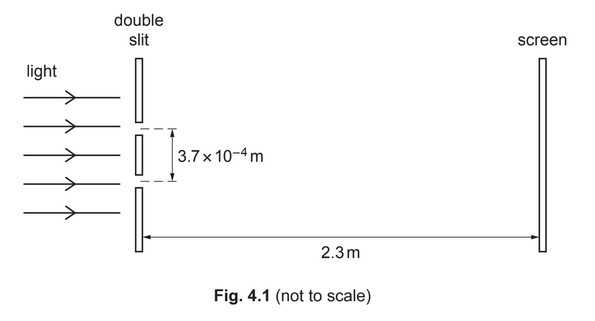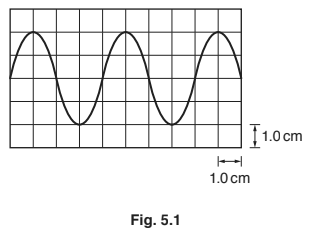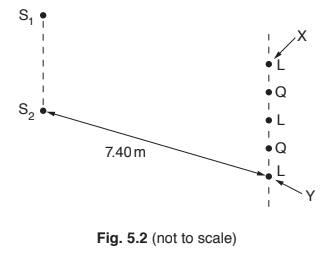Question
(a) (i) By reference to the direction of propagation of energy, state what is meant by a longitudinal wave.
(ii) State the principle of superposition.
(b) The wavelength of light from a laser is determined using the apparatus shown in Fig. 4.1.
The light from the laser is incident normally on the plane of the double slit. The separation of the two slits is \(3.7×10^{–4}\)m. The screen is parallel to the plane of the double slit. The distance between the screen and the double slit is 2.3m. A pattern of bright fringes and dark fringes is seen on the screen. The separation of adjacent bright fringes on the screen is \(4.3×10^{–3}\)m.
(i) Calculate the wavelength, in nm, of the light.
wavelength = …………………………………………… nm
(ii) The intensity of the light passing through each slit was initially the same. The intensity of the light through one of the slits is now reduced.
Compare the appearance of the fringes before and after the change of intensity.
Answer/Explanation
Answer:
(a) (i) vibrations (of particles) are parallel to direction of energy propagation
(ii) waves meet/overlap (at a point)
(b)(i) λ = ax / D
\(= (3.7 × 10^{–4} × 4.3 × 10^{–3}) / 2.3\)
\( = 6.9 \times 10^{-7}\) (m)
= 690 nm
(ii) • no change to fringe separation/fringe width/number of fringes
• bright fringes are darker
• dark fringes are brighter
Any two marking points, 1 mark each
Question
(a) A loudspeaker oscillates with frequency f to produce sound waves of wavelength λ. The loudspeaker makes N oscillations in time t.
(i) State expressions, in terms of some or all of the symbols f, λ and N, for:
1. the distance moved by a wavefront in time t
2. time t.
(ii) Use your answers in (i) to deduce the equation relating the speed v of the sound wave to f and λ.
(b) The waveform of a sound wave is displayed on the screen of a cathode-ray oscilloscope (c.r.o.), as shown in Fig. 5.1.

The time-base setting is \(0.20\, ms\, cm^{−1}\).
Determine the frequency of the sound wave.
(c) Two sources \(S_{1}\) and \(S_{2}\) of sound waves are positioned as shown in Fig. 5.2.

The sources emit coherent sound waves of wavelength \(0.85\) m. A sound detector is moved parallel to the line \(S_{1}S_{2}\) from a point X to a point Y. Alternate positions of maximum loudness L and minimum loudness Q are detected, as illustrated in Fig. 5.2.
Distance \(S_{1}X\) is equal to distance \(S_{2}X\). Distance \(S_{2}Y\) is \(7.40\)m.
(i) Explain what is meant by coherent waves.
(ii) State the phase difference between the two waves arriving at the position of minimum loudness Q that is closest to point X.
(iii) Determine the distance \(S1_Y\)
Answer/Explanation
Ans:
(a) (i) 1. \(N\, λ\)
2. \(N / f\)
(ii) v (= distance / time) = \(N\, λ / (N / f)\) so \(v = f\, λ\)
(b) T = \(4.0 \times 0.20 = 0.80\) (ms) or \(8.0 \times 10^{–4}\) (s)
f = \(1 / 8.0 \times 10^{–4}\)
= \(1300\) Hz
(c) (i) constant phase difference (between the waves)
(ii) \(180\) °
(iii) distance = \(7.40 + (0.85 \times 2)\)
= \(9.1\) m